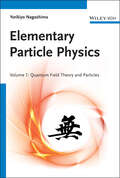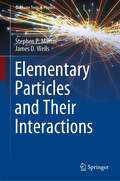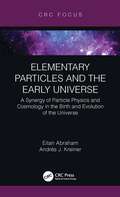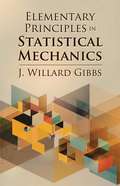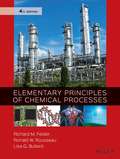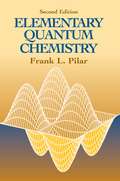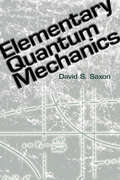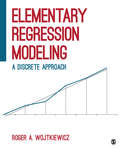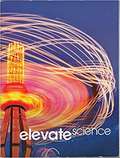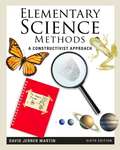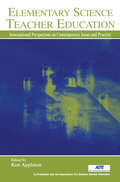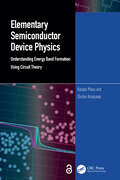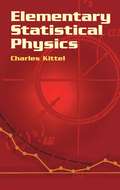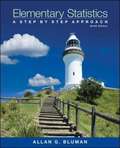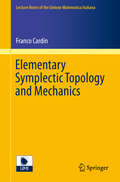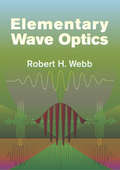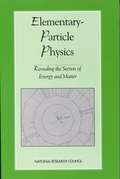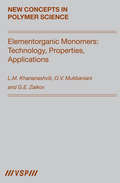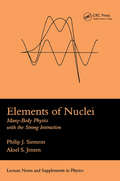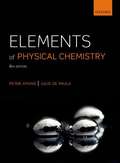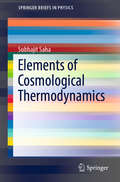- Table View
- List View
Elementary Particle Physics: An Intuitive Introduction
by Andrew J. LarkoskiThis modern introduction to particle physics equips students with the skills needed to develop a deep and intuitive understanding of the physical theory underpinning contemporary experimental results. The fundamental tools of particle physics are introduced and accompanied by historical profiles charting the development of the field. Theory and experiment are closely linked, with descriptions of experimental techniques used at CERN accompanied by detail on the physics of the Large Hadron Collider and the strong and weak forces that dominate proton collisions. Recent experimental results are featured, including the discovery of the Higgs boson. Equations are supported by physical interpretations, and end-of-chapter problems are based on datasets from a range of particle physics experiments including dark matter, neutrino, and collider experiments. A solutions manual for instructors is available online. Additional features include worked examples throughout, a detailed glossary of key terms, appendices covering essential background material, and extensive references and further reading to aid self-study, making this an invaluable resource for advanced undergraduates in physics.
Elementary Particle Physics: Quantum Field Theory and Particles V1
by Yorikiyo NagashimaMeeting the need for a coherently written and comprehensive compendium combining field theory and particle physics for advanced students and researchers, this book directly links the theory to the experiments. It is clearly divided into two sections covering approaches to field theory and the standard model, and rounded off with numerous useful appendices. A timely volume for high energy and theoretical physicists, as well as astronomers, graduate students and lecturers in physics. Volume 2 concentrates on the main aspects of the Standard Model by addressing its recent developments and future prospects. Furthermore, it gives some thought to intriguing ideas beyond the Standard Model, including the Higgs boson, the neutrino, the concepts of the Grand Unified Theory and supersymmetry, axions, and cosmological developments.
Elementary Particles and The Laws of Physics: The 1986 Dirac Memorial Lectures
by Steven Weinberg Richard P. FeynmanPerhaps the two most important conceptual breakthroughs in twentieth century physics are relativity and quantum mechanics. Developing a theory that combines the two seamlessly is a difficult and ongoing challenge. This accessible book contains intriguing explorations of this theme by the distinguished physicists Richard Feynman and Steven Weinberg. Richard Feynman's contribution examines the nature of antiparticles, and in particular the relationship between quantum spin and statistics. In his essay, Steven Weinberg speculates on how Einstein's theory of gravitation might be reconciled with quantum theory in the final laws of physics. Both these Nobel laureates have made huge contributions to fundamental research in physics, as well as to the popularization of science. Anyone interested in the development of modern physics will find this a fascinating book.
Elementary Particles and Their Interactions (Graduate Texts in Physics)
by James D. Wells Stephen P. MartinThe Standard Model of elementary particle physics was tentatively outlined in the early 1970s. The concepts of quarks, leptons, neutrinos, gauge symmetries, chiral interactions, Higgs boson, strong force, weak force, and electromagnetism were all put together to form a unifying theory of elementary particles. Furthermore, the model was developed within the context of relativistic quantum field theory, making it compatible with all of the laws of Einstein's Special Relativity. The successes of the Standard Model over the years have been tremendous and enduring, leading up to the recent discovery and continuing study of the Higgs boson. This book is a comprehensive and technical introduction to Standard Model physics. Martin and Wells provide readers who have no prior knowledge of quantum field theory or particle physics a firm foundation into the fundamentals of both. The emphasis is on obtaining practical knowledge of how to calculate cross-sections and decay rates. There is no better way to understand the necessary abstract knowledge and solidify its meaning than to learn how to apply it to the computation of observables that can be measured in a laboratory. Beginning graduate students, both experimental and theoretical, and advanced undergraduate students interested in particle physics, will find this to be an ideal one-semester textbook to begin their technical learning of elementary particle physics.
Elementary Particles and the Early Universe: A Synergy of Particle Physics and Cosmology in the Birth and Evolution of the Universe
by Eitan Abraham Andrés J. KreinerThe birth of the Universe, and its subsequent evolution, is an exciting blend of Cosmology, Particle Physics and Thermodynamics. This book, with its synoptic approach, provides an accessible introduction to these fascinating topics. It begins in Part I with an overview of cosmology and is followed by a discussion on the present understanding about the birth of the universe, detailing the Planck Era, Inflation, and the Big Bang. It speculates the possibility of multiple universes. Before moving on to explore the essentials of the Standard Model of Particle Physics in Part II, with particular stress on the electroweak force, the first example of acquisition of mass by gauge bosons via the Higgs mechanism. The book finishes in Part III with the thermal history of the Universe. This will also lead to understanding baryonic matter and baryogenesis as well as nucleosynthesis This book is suitable for those taking courses on particle physics, general relativity, and cosmology. Readers mathematically inclined who wish to enhance their basic knowledge about the early Universe, will also find this book suitable to move up to the next level. Features: Authored by experienced lecturers in Particle Physics, Quantum Field Theory, Nuclear Physics, and General Relativity Provides an accessible introduction to Particle Physics and Cosmology
Elementary Principles in Statistical Mechanics: Developed With Especial Reference To The Rational Foundation Of Thermodynamics (Dover Books on Physics)
by J. Willard GibbsWritten by J. Willard Gibbs, the most distinguished American mathematical physicist of the nineteenth century, this book was the first to bring together and arrange in logical order the works of Clausius, Maxwell, Boltzmann, and Gibbs himself. The lucid, advanced-level text remains a valuable collection of fundamental equations and principles. Topics include the general problem and the fundamental equation of statistical mechanics, the canonical distribution of the average energy values in a canonical ensemble of systems, and formulas for evaluating important functions of the energies of a system. Additional discussions cover maximum and minimal properties of distribution in phase, a valuable comparison of statistical mechanics with thermodynamics, and many other subjects.
Elementary Principles of Chemical Processes
by Richard M. Felder Ronald W. RousseauElementary Principles of Chemical Processes, 4th Edition prepares students to formulate and solve material and energy balances in chemical process systems and lays the foundation for subsequent courses in chemical engineering. The text provides a realistic, informative, and positive introduction to the practice of chemical engineering.
Elementary Quantum Chemistry, Second Edition (Dover Books on Chemistry)
by Frank L. PilarAs the author notes in the Preface to this valuable text, experimental chemists have moved past studying the average behavior of atoms or molecules "to probe the step-by-step behavior of individual atoms and molecules as they collide, form 'transition states,' and ultimately form products." In such experiments, quantum mechanical computations do two useful tasks: They fill in the observational gaps and help to interpret what has been observed.This introductory course -- developed by the former chairman of the chemistry department at the University of New Hampshire -- covers, among other topics, the origins of the quantum theory, the Schrödinger wave equation, the quantum mechanics of simple systems, the rigid rotator, the hydrogen atom, electron spin and many-electron systems, the quantum states of atoms, the Hartree-Fock self-consistent field method, the electronic structure of molecules, and semi-empirical molecular orbital methods. One of the great values of the course is its calculations and diagrams, which were created specifically for this text and which students will be able to replicate on their home computers.The text will be most useful for advanced undergraduate or beginning graduate students who have had calculus and at least a year of undergraduate physics. A knowledge of differential equations, linear algebra, and atomic physics is helpful but not essential. Seven appendices give a concise exposition of mathematical and physical material that may not be part of the students' background.
Elementary Quantum Mechanics (Dover Books on Physics)
by David S. SaxonBased on lectures for an undergraduate UCLA course in quantum mechanics, this volume focuses on the formulas of quantum mechanics rather than applications. Widely used in both upper-level undergraduate and graduate courses, it offers a broad self-contained survey rather than in-depth treatments.Topics include the dual nature of matter and radiation, state functions and their interpretation, linear momentum, the motion of a free particle, Schrödinger's equation, approximation methods, angular momentum, and many other subjects. In the interests of keeping the mathematics as simple as possible, most of the book is confined to considerations of one-dimensional systems. A selection of 150 problems, many of which require prolonged study, amplify the text's teachings and an appendix contains solutions to 50 representative problems. This edition also includes a new Introduction by Joseph A. Rudnick and Robert Finkelstein.
Elementary Regression Modeling: A Discrete Approach
by Roger A. WojtkiewiczElementary Regression Modeling builds on simple differences between groups to explain regression and regression modeling. User-friendly and immediately accessible, this book gives readers a thorough understanding of control modeling, interaction modeling, modeling linearity with spline variables, and creating research hypotheses that serve as a conceptual basis for many of the processes and procedures quantitative researchers follow when conducting regression analyses.
Elementary Regression Modeling: A Discrete Approach
by Roger A. WojtkiewiczElementary Regression Modeling builds on simple differences between groups to explain regression and regression modeling. User-friendly and immediately accessible, this book gives readers a thorough understanding of control modeling, interaction modeling, modeling linearity with spline variables, and creating research hypotheses that serve as a conceptual basis for many of the processes and procedures quantitative researchers follow when conducting regression analyses.
Elementary Science
by Scott ForesmanNext Generation Science Standards is a registered trademark of Achieve. Neither Achieve nor the lead states and partners that developed the Next Generation Science Standards were involved in the production of this product, and do not endorse it. NGSS Lead States. 2013. Next Generation Science Standards: For States, By States. Washington, DC: The National Academies Press.
Elementary Science Methods: A Constructivist Approach
by David Jerner MartinIn this pioneering text, a constructivist approach guides users in learning how to teach in a constructivist manner. The book is based on the belief that items more important for children to learn how to do science than it is for them to learn about science, and that teachers of elementary science do not need to know a great deal of science to teach it effectively, but rather need to be co-inquirers with their students. More than 170 process-oriented activities, organized by grade level, help practicing teachers encourage children to develop and perform their own investigations.
Elementary Science Teacher Education: International Perspectives on Contemporary Issues and Practice
by Ken AppletonCo-Published with the Association For Science Teacher Education. Reflecting recent policy and standards initiatives, emerging research agendas, and key innovations, this volume provides a contemporary overview of important developments and issues that have that have in recent years shaped elementary science education pre-service courses and professional development, and practices that are shaping future directions in the field. Contributors from several countries who are actively engaged in research and design in elementary science education address:*Conceptual issues which impinge on contemporary science teacher education;*Intersections of content, pedagogy, and practice; and*Professional development as a contextualized practice.Elementary Science Teacher Education: International Perspectives on Contemporary Issues and Practice offers a clear picture of the current state of the field and directions for the future--to the benefit of elementary science teacher educators, aspiring teacher educators, school policy makers, other professionals involved in science education and, ultimately, the millions of elementary school children who will gain from improved practice.
Elementary Semiconductor Device Physics: Understanding Energy Band Formation Using Circuit Theory
by Kazuya Masu Shuhei AmakawaThis book by two leading experts on integrated circuit design adopts an untraditional approach to introducing semiconductor devices to beginners. The authors use circuit theory to provide a digestible explanation of energy band theory and understanding of energy band diagrams. After briefly summarizing the basics of semiconductors, the authors describe semiconductor devices from a circuit theoretic point of view, making the book especially suitable for circuit design students and engineers. Further to the emphasis on the circuit perspective, the book then uses circuit theory to introduce readers to the famously indigestible “energy bands” of crystalline solids. Additionally, the book explains how to read physics from “energy band diagrams” of semiconductor devices in great detail. The key to appreciating the real power of energy band diagrams is shown to lie in the understanding of the concept of the “quasi-Fermi levels,” introduced in 1949 by William Shockley but remaining elusive to date and therefore often omitted from energy band diagrams. To rectify this, some of the energy band diagrams presented in this book, complete with quasi-Fermi levels, were drawn using a device simulator (a.k.a. technology computer-aided design; TCAD), offering quantitative information about device physics. The book could, therefore, also serve as a hands-on course text in TCAD-drawn band diagram reading.Because no prior exposure to quantum mechanics is required and the book does not attempt to teach it, this book is ideal for students in various disciplines who may or may not be specializing in semiconductor devices. The numerous practical examples of reading TCAD-based energy-band diagrams are also invaluable to practicing semiconductor device engineers.
Elementary Statistical Physics
by Charles KittelNoteworthy for the philosophical subtlety of its foundations and the elegance of its problem-solving methods, statistical mechanics can be employed in a broad range of applications -- among them, astrophysics, biology, chemistry, nuclear and solid state physics, communications engineering, metallurgy, and mathematics. Geared toward graduate students in physics, this text covers such important topics as stochastic processes and transport theory in order to provide students with a working knowledge of statistical mechanics.To explain the fundamentals of his subject, the author uses the method of ensembles developed by J. Willard Gibbs. Topics include the properties of the Fermi-Dirac and Bose-Einstein distributions; the interrelated subjects of fluctuations, thermal noise, and Brownian movement; and the thermodynamics of irreversible processes.Negative temperature, magnetic energy, density matrix methods, and the Kramers-Kronig causality relations are treated briefly. Most sections include illustrative problems. Appendix. 28 figures. 1 table.
Elementary Statistics: A Step By Step Approach (Ninth Edition)
by Allan G. BlumanElementary Statistics: A Step By Step Approach is for introductory statistics courses with a basic algebra prerequisite. The text follows a nontheoretical approach, explaining concepts intuitively and supporting them with abundant examples. In recent editions, Al Bluman has placed more emphasis on conceptual understanding and understanding results. Additionally step-by step instructions on how to utilize the TI-84 Plus graphing calculator, Excel, and Minitab, have also been updated to reflect the most recent editions of each technology.
Elementary Symplectic Topology and Mechanics
by Franco CardinThis is a short tract on the essentials of differential and symplectic geometry together with a basic introduction to several applications of this rich framework: analytical mechanics, the calculus of variations, conjugate points & Morse index, and other physical topics. A central feature is the systematic utilization of Lagrangian submanifolds and their Maslov-Hörmander generating functions. Following this line of thought, first introduced by Wlodemierz Tulczyjew, geometric solutions of Hamilton-Jacobi equations, Hamiltonian vector fields and canonical transformations are described by suitable Lagrangian submanifolds belonging to distinct well-defined symplectic structures. This unified point of view has been particularly fruitful in symplectic topology, which is the modern Hamiltonian environment for the calculus of variations, yielding sharp sufficient existence conditions. This line of investigation was initiated by Claude Viterbo in 1992; here, some primary consequences of this theory are exposed in Chapter 8: aspects of Poincaré's last geometric theorem and the Arnol'd conjecture are introduced. In Chapter 7 elements of the global asymptotic treatment of the highly oscillating integrals for the Schrödinger equation are discussed: as is well known, this eventually leads to the theory of Fourier Integral Operators. This short handbook is directed toward graduate students in Mathematics and Physics and to all those who desire a quick introduction to these beautiful subjects.
Elementary Wave Optics
by Robert H. WebbThis undergraduate textbook presents thorough coverage of the standard topics of classical optics and optical instrument design; it also offers significant details regarding the concepts of modern optics. Its survey of the mathematical tools of optics grants students insights into the physical principles of quantum mechanics.Two principal concepts occur throughout: a treatment of scattering from real scatterers (leading to Huygens' principles, diffraction theory, the index of refraction, and related topics); and the difference between coherent and noncoherent wave phenomena. Examinations of superimposition of field amplitudes and detection of intensities recur throughout the book.This highly physical approach is augmented by extensive appendixes of mathematical details. Two sets of problems appear at the end of each chapter and form a crucial part of the exposition. One set consists of well-tested problems with detailed solutions, paired with similar problems without supplied solutions. The other set contains short, easier exercises, filling the more conventional role of end-of-chapter problems.
Elementary-Particle Physics: Revealing the Secrets of Energy and Matter
by Committee on Elementary-Particle PhysicsPart of the Physics in a New Era series of assessments of the various branches of the field, Elementary-Particle Physics reviews progress in the field over the past 10 years and recommends actions needed to address the key questions that remain unanswered. It explains in simple terms the present picture of how matter is constructed. As physicists have probed ever deeper into the structure of matter, they have begun to explore one of the most fundamental questions that one can ask about the universe: What gives matter its mass? A new international accelerator to be built at the European laboratory CERN will begin to explore some of the mechanisms proposed to give matter its heft. The committee recommends full U.S. participation in this project as well as various other experiments and studies to be carried out now and in the longer term.
Elementorganic Monomers: Technology, Properties, Applications
by Gennady E. Zaikov L.M. Khananashvili O.V. MukbanianiNew fields of science and technology call for new materials with valuable performance characteristics. Long-term resistance to such temperatures can be found only in polymers with chains made up of thermostable fragments. Particularly interesting in this respect are elementorganic polymers with inorganic and organo-inorganic molecular chains. Elementorganic polymers are not only highly thermostable, but also perform well under low temperatures, sunlight, humidity, weather, etc. Thus, these polymers (especially silicones) are widely and effectively used in the electrical, radio, coal, mechanical rubber, aircraft, metallurgical, textile, and other industries. They are of great utility not only in industry, but also in households and in medicine, where their merits can hardly be overestimated.The need to publish this book arose with the scientific and technical developments of the last decade, the reconstruction and technical renovation of existing factories, as well as fundamental changes in some syntheses of elementorganic monomers and polymers. Moreover, nowadays it is essential to train highly skilled chemical engineers with a comprehensive knowledge of current chemistry, of the production technology of elementorganic monomers and polymers, and of their characteristics and applications.
Elements Of Ecology (Ninth Edition)
by Robert Leo Smith Thomas M. SmithElements of Ecology, Ninth Edition continues to explain ecological processes clearly and concisely, with a greater emphasis on the relevance of ecology to everyday life and the human impact on ecosystems. This dramatically revised edition discusses issues of human ecology throughout the text and provides a greater variety of opportunities for students to learn, practice, and develop quantitative and analytical skills.
Elements Of Nuclei: Many-body Physics With The Strong Interaction
by Philip J. SiemensIn the present volume, Phillip J. Siemens, who has been a seminal contributor to our understanding of the nucleus as a many-body system, and his able collabourator, Aksel S. Jensen, introduce graduate students and colleagues in other fields to the basic concepts of nuclear physics in a way which connects clearly the methods of nuclear physics with those of condensed matter, atomic, and particle physics. Their book thus provides a lucid introduction to the key facts and concepts of nuclei, including many of the most recent developments, while emphasizing the similarities and the differences between the behaviour of nuclei, atoms, elementary particles, and condensed matter, It should thus prove useful, not only as a text for an introductory graduate course in nuclear physics, but as a reference book for all scientists interested in a unified picture of our understanding of physical phenomena associated with many-body systems.
Elements Of Physical Chemistry
by David Smith Peter Atkins Julio De PaulaGetting to grips with physical chemistry can be a daunting task. With new concepts to understand and a large amount of mathematics to master, it is no wonder that students can sometimes find it overwhelming. Elements of Physical Chemistry has been carefully developed to help students increase their confidence when using physics and mathematics to answer fundamental questions about the structure of molecules, how chemical reactions take place, and why materials behave the way they do. New to this edition: A new Foundations chapter introduces the topics that are needed to understand the principles later in the text, such as classical mechanics and electromagnetism. Chemist's toolkits are used throughout the text to remind students of a variety of mathematical techniques or introductory chemistry needed to follow material in the chapters. Labels are attached to all the main equations to help students recall their meaning and relevance New Road Maps provide a structured summary of equations, showing the relations between expressions.
Elements of Cosmological Thermodynamics (SpringerBriefs in Physics)
by Subhajit SahaBased on the author’s own work and results obtained by renowned cosmologists, this short book provides a concise introduction to the relatively new research field of cosmological thermodynamics. Starting with a brief overview of basic cosmology and thermodynamics, the text gives an interesting account of the application of horizon thermodynamics to the homogeneous and isotropic Friedmann-Lemaitre-Robertson-Walker (FLRW) model, the inhomogeneous (Lemaitre-Tolman-Bondi) LTB model, and the gravitationally induced adiabatic particle creation scenario which is considered to be a viable alternative to the concordance Lambda-CDM model of the Universe. Both seasoned and new researchers in this field will appreciate the lucid presentation and the rich bibliography.

